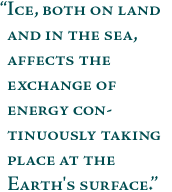
 |
||
|
|
||
|
Polar ice consists of sea ice formed from the freezing of sea water, and ice sheets and glaciers formed from the accumulation and compaction of falling snow. Both types of ice extend over vast areas of the polar regions. Global sea-ice coverage averages approximately 25 million km2, the area of the North American continent, whereas ice sheets and glaciers cover approximately 15 million km2, roughly 10% of the Earth's land surface area.
Effects on Energy Exchange
On the other hand, if global warming occurs, then more ice would be expected to melt, reducing the energy reflected back to space and increasing the energy absorbed at the surface. The affected portions of the Earth would become still warmer. Scientists refer to this kind of reinforcing process as a "positive feedback." |

Polar Ice
|
|
Subscribe to the Earth Observatory About the Earth Observatory Contact Us Privacy Policy and Important Notices Responsible NASA Official: Lorraine A. Remer Webmaster: Goran Halusa We're a part of the Science Mission Directorate |
|
|